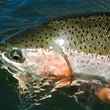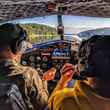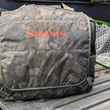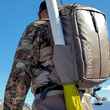These days, when I travel to fish, I've become accustomed to eating huge airline baggage fees. In fact, I've simply been trained into factoring $150-$300 extra in baggage fees into my travel budgeting. For anglers like myself and most others with whom I've slogged my way through airports, the usual setup goes something like this: a rod + reel case, a gear bag (boots, waders, flies, lines and other misc gear) and a duffel or suitcase with your clothes and toiletries. Sadly, 1 + 1 + 1 = 3 and 3 is the magic number. The magic number, that is, where virtually every major airline hits you with a $150 excess baggage fee (in addition to any other baggage fees you've already paid) and ruins your day—especially once you realize you're going to have to pay it all again on the way home.
For some time, I found creative ways to avoid reaching that magic number. Often, I'd leave my rod and reel combo case at home, despite its vast organizational advantages, stuff the reels into my duffel, and tote the rods on board. Over the years, however, most airlines stopped allowing rod cases in the overhead compartments and started requiring me to check them. More often, I found myself more interested in using my carry-on allowance to take on board my cameras and laptop and other sensitive equipment I didn't want the baggage handlers having their way with. So I found myself back at that magic number. Either that, or calling ahead to my destination to see what gear I could borrow and thus cut from my packing needs.
But this year, while reading through the fine print of American Airlines' baggage policy, I made a discovery that has allowed me to make 1 + 1 + 1 = 2. And, when 1 + 1 + 1 adds up to 2, it also adds up to major savings.
Now, reading through airline baggage policies isn't my idea of a good time. It's probably not your's either. But, in preparation for a recent trip to Argentina, I found myself doing just that. I couldn't remember how the baggage allowances varied on international and domestic flights and so I went digging. In the process of doing so, I stumbled upon information that saved me $300 in baggage fees on my recent trip and that should continue to save me a lot of money each and every time I travel for fishing.
As it turns out, most major U.S. airlines have a special equipment baggage policy that applies specifically to fishing gear. Put simply, this policy allows multiple pieces of fishing gear (rods, reels, boots, nets and other tackle) to count as a single item—even when packed completely separately.
More Like This
I've long been familiar with special equipment baggage policies—most skiers and snowboarders are accustomed to their ski or board bag and separate boot/helmet bag counting as a single item—but was completely unaware that such a policy existed for fishing gear.
And it seems that most other anglers were as in the dark as I was. Upon my discovery, I excitedly related this finding to other anglers I had previously traveled with or others I knew that frequently rode airplanes to fishy destinations. Not one of them had ever heard of it. I relayed the info to a travel logistics company that specializes in helping anglers. They had no idea. There it was, this bit of fine print that has the potential to save every angler hundreds of dollars in baggage fees, hiding in plain sight.
Not every airline has an angler-friendly special equipment baggage policy. Delta conspicuously lacks one. Frontier also lacks one, although completely inconspicuously, given that Frontier's business model seems to be advertising low fares and then nickel-and-diming its customers for everything from carry-on bags to Coca-Cola.
The particulars vary by airline and the particulars matter. In general, however, most of the other major carriers in the U.S. (American, United, Alaska and Southwest) and many foreign carriers (Air Canada and Icelandair) allow you to take some combination of rods, reels, boots, a landing net and a variety of other tackle packed in separate bags and count them as one item.

American Airlines seems to have the most generous policy, which is a good thing given that American is the largest U.S. carrier. American's policy allows you to travel with a case/bag containing nondescript "rods and reels" and a separate "equipment bag" and count the combo as one single item. This policy allowed me to take 5 rods and 5 reels in my Fishpond Dakota Rod + Reel case and a YETI Panga duffel stuffed waders, boots, hordes of fly boxes, fly lines, a waist pack, leaders, tippet, buffs, pliers and at least a dozen other pieces of fishing gear and have it all count as one item. If I hadn't known about the policy, the Fishpond case would've cost me $150 each way, as it has many times before.
Other airlines are a bit more restrictive. Alaska limits you to two rods and two reels plus one tackle bag. United's policy is virtually identical to Alaska's, although they want you to get by with one reel instead of two. Southwest doesn't even mention reels, though presumably they don't expect you to go without one.
The language in each airline's policy is, frankly, a bit vague—especially given the vast variety of fishing gear out there—but the intention of these policies all seems clear: to allow anglers to travel with multiple pieces of fishing gear and not get slammed with excess baggage fees.
The manner in which each airline applies and enforces their policy will likely come down to the staff you encounter when you arrive at the check-in counter. How far you try to push it is up to you, but here are some tips on how to successfully take advantage of these special policies.
- Keep the combo under 50 pounds (or whatever each airline's single item weight limit is). This is the big one. The airlines are allowing you to count multiple pieces of fishing gear as one item, but they aren't going to allow you to tote on extra weight.
- Don't pack anything that can't reasonably pass as fishing tackle/equipment in your gear bags and cases. Your fishing equipment must contain only fishing gear. Fishing shirts aren't tackle. Neither are wool caps. Or your GoPro. Heck, Buffs might even be pushing it. I was even asked to remove a book from my rod case. But boots, waders, fly boxes, lines, lanyards, nippers, pliers, etc? That should all fly.
- Don't expect the airline staff to be any more informed about special equipment policies applying to fishing gear than you or other anglers seem to be. Every time I've informed the check-in agent that I need to check specialty fishing equipment, they've needed to look the policy up and consult with a manager for approval.
- Arrive a little early. Because the airline staff likely won't be familiar with their own specialty equipment policy as it applies to fishing gear and will almost certainly need to consult a manager, you're going to eat up some time wading through that process. If you're scrambling to get to your gate, you won't have the time to spare.
- Be informed. Look up the special equipment policy of the airline(s) you are flying. It can even help to print it out and bring a copy with you to check-in.
- Stay up-to-date. The airlines regularly revise their special equipment policies (typically to make them more restrictive rather than less, unfortunately). So don't rely on information you find anywhere (including here) other than your airline's website or other official documentation immediately prior to your trip.
Even if your fly fishing trips saddle you with less gear that I do, these specialty equipment policies can still add up to big savings by allowing you to count two bags as one—which will typically save you at least $35 each way.































Comments
Richard Weiland replied on Permalink
Great article. I often resorted to using a Pelican hard case (e.g. 1700 model) in which I can place roofs, reels, boots, waders, landing net, etc. The upside is one fishing case (lower cost), protects gears from damage in transports, has two wheels, and it can be locked. The down side is it’s not a cheap piece of ‘luggage’, it weights 16 lbs, may be too long for some small planes overseas, and most people use these as gun cases which typically requires an explanations, may need to be opened to show contents when traveling overseas and commonly has to be picked up at a specialty baggage locations (even in the US). Bottom line it works but I like your solution as well. Thanks for finding img and reading the fine print for us all. Cheers - Rich
Dan LaForme replied on Permalink
From Air Canada:
https://www.aircanada.com/ca/en/aco/home/plan/baggage/special-items.html
When packed separately, each of the following counts as one piece of baggage towards the maximum number of checked bags allowed by your fare type:
fishing rod in rod case + tackle box
tackle bag + reels
landing net
boots
life jacket
One self-inflating life jacket per person is accepted in both carry-on and checked baggage provided:
it’s fitted with a maximum of two small cylinders of carbon dioxide or another suitable gas in Division 2.2, and
it’s accompanied by no more than two spare cylinders.
Waivers / Charges
Fishing rod in rod case:
NO oversize or additional piece charges apply if carried with tackle box.
All other additional checked baggage rules apply.
Packing instructions
The fishing rod(s) must be packaged in a rigid and/or hard shell container specifically designed for shipping.
If packaged differently, items may be refused for carriage. We’re not liable if and to the extent that any damage results from the inherent defect, quality or vice of the baggage.
Anonymous replied on Permalink
A more obvious solution is to pack everything (except rods) in a very large suitcase. Just stay under the 50lb limit. Airlines allow really large suitcases which hold everything you need. This is what I've done for some time, without any issues.
Bill A replied on Permalink
Thanks for the good info. I have never had an airline question putting rod tubes in the overhead compartment, but I have only travelled domestically.
Pages